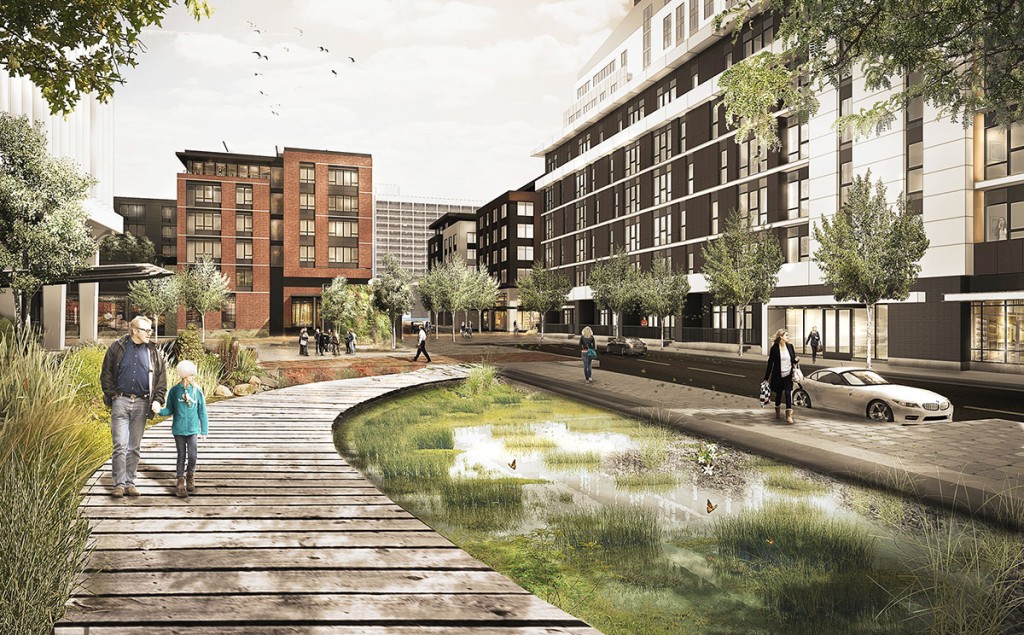As we begin to emerge from the recession that has plagued the last half decade, restorative efforts are taking place in communities across the Pacific Northwest. The key is finding ways to reshape these areas in a manner that is beneficial to the environment, while not straining budgets. One significant approach we at Glumac feel is essential to these restorative efforts is a design strategy that was first developed here in the Pacific Northwest called EcoDistricts.
While the commercial building industry has focused more and more on energy efficiency—almost always seeking to optimize the performance of a single building—we at Glumac took a renewed focus on efficiency solutions beyond the single building scale, crafting energy, water and waste systems that find greater efficiency by connecting buildings together. At Glumac we call this shared infrastructure an EcoDistrict System, a concept whose potential environmental and economic benefits are incredible.

The benefits of EcoDistrict Systems go far beyond a reduced environmental footprint, transforming the economics of a project. Advanced energy and water systems can become very affordable when costs are spread across multiple buildings. Buildings connecting to efficient central systems can benefit from long-term operational savings. Beyond the economics, the value of a neighborhood, campus or community united behind common goals with a unique culture of sustainability cannot be overlooked.
“The Hassalo on Eighth development will transform
four city blocks in Portland, and EcoDistrict Systems
play a key role.”
District systems are an old idea, but Glumac is approaching them with a new focus. Early Edison power plants produced electricity and steam for small neighborhoods in New York City. Closer to home, wood waste powered district heating systems once served communities throughout the Pacific Northwest, including parts of downtown Portland. This scale of system is back, but with a focus on reduced environmental impact. Today, the EcoDistrict Systems Glumac is designing fall into three main areas of resource-efficiency: Energy, Water and Waste.
ENERGY: A shared condenser water loop—what Glumac calls an EcoLoop—connects the heating and cooling systems of multiple buildings at once. Individually, each building can reject heat to the loop when cooling is needed or extract heat from it when heating is needed. So, when some buildings on a loop require heating while others need cooling, the loop can use energy from one building to meet the needs of another, drastically reducing the amount of heating and cooling energy expended by each individual building.

Glumac is involved in numerous large EcoLoop projects, from southern California to Japan. On the northern edge of Tokyo, on a project led by ZGF Architects, we are proposing a major EcoLoop system in the growing Smart City of Kashiwa no Ha. This modular condenser water loop will grow with the development, connecting small groups of buildings and using the constant temperature of ground water as an extra source of thermal energy.
Closer to home, we’re working on a central condenser water system for Hassalo on Eighth, a four block development in Portland’s Lloyd District planned and designed by GBD Architects. The majority of the mechanical equipment for this system will be installed in an existing office building constructed in the 1970s. With more efficient equipment and systems, its mechanical room will be able to serve three new buildings, saving significant space in the new buildings and providing greater energy efficiency overall.
WATER: Recent droughts in the U.S. have emphasized the value of clean water and demonstrated the shortages we all may face without new approaches to water efficiency and reuse. At the Hassalo on Eighth project a district wastewater treatment system will serve four city blocks, turning sewage into reusable water onsite, virtually eliminating use of the city sewer.
This natural wastewater treatment system—engineered with Glumac partner Biohabitats—uses biological action in constructed wetland cells to purify the wastewater with minimal energy and almost no use of chemicals. The resulting water will be used to flush toilets, cool buildings, and irrigate green roofs and landscape. The system will divert more than 16 million gallons of wastewater from the sewer every year, providing 4.6 million gallons of water for reuse. Importantly, the system will pay for itself in four years.
WASTE: Disposing of solid waste is a burden on every community. It requires enormous landfills, and often, long distance transportation. However, technology exists to actually turn much of this waste into a resource at a much smaller scale. At Kashiwa no Ha, Glumac is proposing a community-scale anaerobic digester, which is a series of large closed tanks that ferments organic waste into methane and compost. The digester system, based on working examples in many countries around the world, would reduce solid waste by up to 40 percent, generate methane gas for use in the district and recycle nutrients into agriculture-ready compost.
Feeding this digester would be a vacuum waste collection system which takes sorted waste from intakes the size of mailboxes positioned in and around buildings. This system of underground pneumatic tubes can run up to a kilometer through a neighborhood, and will eliminate the need for large waste bins and for garbage and recycling trucks.
These systems are only part of the broader EcoDistrict approach to sustainability in the built environment. As one member of a comprehensive design team, we are partnering with planners, urban designers, architects and landscape architects to envision neighborhoods and campuses that address all aspects of sustainability in the built environment.
These emerging district system approaches are ideal for mixed-use developments, and especially for college and corporate campuses. We look forward to helping more clients understand the value of connecting multiple buildings together and dealing with environmental impact at a scale beyond individual buildings. EcoDistricts are a powerful strategy that benefits all of us, our communities and our budgets.
Images courtesy of GBD Architects. Copyright 2014.
Rem Wilson is a Principal at Glumac, and serves as a member of the Clark County Solid Waste Advisory Commission. For more information, please email us at [email protected].

